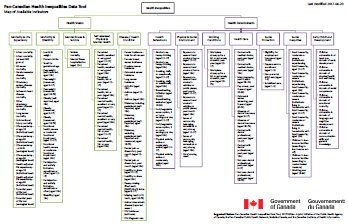Health Inequalities Data Tool
Health inequalities refer to differences in health status between groups in society. These differences can be due to biological factors, individual choices, or chance, but public health evidence suggests that many are attributable to the unequal distribution of the social and economic factors that influence health (e.g. income, education, employment, social supports) and exposure to societal conditions and environments largely beyond the control of the individuals concerned.
In 2012, Canada, along with other World Health Organization (WHO) Member States, endorsed the Rio Political Declaration on Social Determinants of Health, pledging to take action to promote health equity (defined by the WHO as “the absence of avoidable or remediable differences among groups of people”). Strengthening the capacity to monitor and report on health inequalities was recognized as a critical foundation for achieving meaningful progress towards this goal.
The Health Inequalities Data Tool supports Canada’s pledges under the Rio Declaration. This resource is a collaborative effort of the Public Health Agency of Canada, the Pan-Canadian Public Health Network (PHN), Statistics Canada, and the Canadian Institute for Health Information, and builds on a set of indicators of health inequalities proposed by the PHN in 2010.
The Health Inequalities Data Tool contains data on indicators of health status and health determinants, stratified by a range of social and economic characteristics (i.e. social stratifiers) meaningful to health equity. Indicators are grouped into twelve framework components.

More Information
For more information about each indicator, click on the framework components below:
More information is available about the measures of inequality used in this Data Tool.
Notes
Data Sources (Abbreviations): Canadian Cancer Registry (CCR); Canadian Community Health Survey - Annual Component (CCHS); Canadian Demographic Estimates, Canadian Health Measures Survey (CHMS); Canadian Survey on Disability (CSD); Canadian Tuberculosis Reporting System (CTBRS); Census Population Counts; Early Development Instrument, Offord Centre for Child Studies (EDI); Employment Insurance Coverage Survey (EICS); Hospital Mental Health Database, Canadian Institute for Health Information (HMHDB); National HIV/AIDS Surveillance System; National Household Survey (NHS); Survey of Young Canadians (SYC); Vital Statistics - Birth Database (VS-BD); Vital Statistics - Death Database (VS-DD).
Rates: Age-standardized to the 2011 Canadian population unless otherwise stated. Rates encompass incidence and prevalence. Consult the documentation for more details on a specific indicator.
Stratification: Where possible/applicable, indicators are stratified at the individual level by the following characteristics: individual respondent/household income (income quintile – provincial/national, overall and by rural/urban geography); education level/quintile (individual respondent/household, overall and by rural/urban geography); immigration status; First Nations/Inuit/Métis identity; deprivation index (social/material); employment status; occupation; rural/urban geography; cultural/racial background; sexual orientation; functional health; participation and activity limitation; and impact of health problems. In certain cases, categories within a stratifier are collapsed or replaced by a proxy measure in cases of small sample sizes or unavailable information. Consult the documentation for more details on the available stratifiers for a specific indicator.
Ecological stratifiers are used in cases of missing or unavailable individual level characteristics. These measures are based on the use of area level measures1 of socio-economic status, sub-group (e.g. First Nations/Inuit/Métis identity, foreign-born2) concentration and rural/urban geography derived from the 2006 Census (long-form) at the Census Dissemination Area (DA) level and linked to the vital and cancer administrative data available at Statistics Canada using the Postal Code OM Conversion File Plus (PCCF+).
Data availability, validity and limitations: When an indicator and a stratifier are crossed, the age interval is limited to that available in both the indicator and the stratifier. The values calculated for the summary measures of inequalities do not take into account the complex intersections between different social identities or different social determinants of health that may vary between the groups. Consult the documentation on the summary measures of inequalities used in this project for more details. Data from national surveys were weighted to permit representative estimates of the target population. The 95% confidence interval illustrates the degree of variability associated with a number or a rate. Wide confidence intervals indicate high variability and should therefore be interpreted and compared with caution. For indicators using data linkage to the 2006 census data via the PCCF+, records that could not be assigned a DA were excluded from the analysis.
Suggested Citation: Pan-Canadian Health Inequalities Data Tool, 2017 Edition. A joint initiative of the Public Health Agency of Canada, the Pan-Canadian Public Health Network, Statistics Canada and the Canadian Institute of Health Information.
Correspondence: Determinants of Health Division, Public Health Agency of Canada, 9th floor, 785 Carling Avenue, A.L. 6809B, Ottawa, ON K1A 0K9; Email: HealthInequalities_InegalitesEnSante@phac-aspc.gc.ca
References:
- 1 Peters PA, Oliver LN, Carrière G. Geozones: An area-based method for analysis of health outcomes. Health Reports 2012; 23(1):1-10.
- 2 Carrière G, Peters PA, Sanmartin C. Area-based methods to calculate hospitalization rates for the foreign-born population in Canada, 2005/2006. Health Reports 2012; 23(3):1-10.
Acknowledgements: The development of this Data Tool was made possible through collaboration of the Public Health Agency of Canada (PHAC), the Pan-Canadian Public Health Network (PHN), Statistics Canada, and the Canadian Institute for Health Information (CIHI). We wish to thank the members of the Pan-Canadian Health Inequalities Reporting Initiative Technical Working Group for their invaluable contributions to this product.